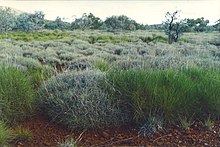Triodia (plant)
| Triodia | |
|---|---|

| |
| Triodia pungens (green) and Triodia basedowii (blue-grey) | |
| Scientific classification | |
| Kingdom: | |
| (unranked): | |
| (unranked): | |
| (unranked): | |
| Order: | |
| Family: | |
| Genus: | Triodia |
| Synonyms[1][2] | |
|
Plectrachne Henrard | |
Triodia is a large genus of hummock-forming bunchgrass endemic to Australia. They are known by the common name spinifex, although they are not a part of the coastal genus Spinifex.[1] Many of the soft-leaved members of this species were formerly included in the genus Plectrachne.[3]
Description
Triodia is a perennial Australian tussock grass which grows in arid regions and has awl-shaped, pointed leaves. The leaf tips (high in silica) can break off in the skin, leading to infections. Leaves are 30–40 centimetres long.
Uses
Spinifex has traditionally had many uses for Australian Aborigines. The seeds were collected and ground to make seedcakes. Spinifex resin was an important adhesive used in spear-making. Smoke signals were made to communicate with families and groups a long distance away, as burning spinifex produces a strong black smoke.
The species Triodia wiseana is used for building shelters; bunched together it is used for trapping fish against creek beds. It is called baru in the languages of the Yindjibarndi and Ngarluma people, the English term is hard spinifex.[4]

Species
Species currently include:[5][6]
- Triodia acutispicula Lazarides
- Triodia aeria Lazarides
- Triodia angusta (Burbidge, N.T)
- Triodia aristiglumis (Lazarides) Lazarides
- Triodia aurita Lazarides
- Triodia barbata R.L.Barrett & M.D.Barrett
- Triodia basedowii E.Pritz. – buck spinifex
- Triodia biflora Lazarides
- Triodia bitextura Lazarides
- Triodia brizoides (Burbidge, N.T)
- Triodia bromoides (F.Muell.) Lazarides
- Triodia bunglensis (S.W.L.Jacobs) Lazarides
- Triodia bunicola (S.W.L.Jacobs) Lazarides – southern porcupine grass
- Triodia burbidgeana S.W.L.Jacobs
- Triodia bynoei (C.E.Hubb.) Lazarides
- Triodia caelestialis G.Armstr.
- Triodia claytonii Lazarides
- Triodia compacta (Burbidge, N.T) S.W.L.Jacobs
- Triodia concinna (Burbidge, N.T)
- Triodia contorta (Lazarides) Lazarides
- Triodia cremmophila R.L.Barrett & M.D.Barrett
- Triodia cunninghamii Benth.
- Triodia danthonioides (F.Muell.) Lazarides
- Triodia desertorum (C.E.Hubb.) Lazarides
- Triodia dielsii (C.E.Hubb.) Lazarides
- Triodia epactia S.W.L.Jacobs
- Triodia fissura Barrett, Wells & Dixon
- Triodia fitzgeraldii C.A.Gardner ex N.T.Burb.
- Triodia helmsii (C.E.Hubb.) Lazarides
- Triodia hubbardii (Burbidge, N.T)
- Triodia inaequiloba (Burbidge, N.T)
- Triodia integra Lazarides
- Triodia intermedia Cheel – winged spinifex
- Triodia inutilis (Burbidge, N.T)
- Triodia irritans (Brown, R) – porcupine grass
- Triodia lanata J.M.Black
- Triodia lanigera Domin
- Triodia latzii Lazarides
- Triodia longiceps J.M.Black
- Triodia longiloba Lazarides
- Triodia longipalea Lazarides
- Triodia marginata (Burbidge, N.T)
- Triodia melvillei (C.E.Hubb.) Lazarides
- Triodia microstachya (Brown, R)
- Triodia mitchellii Benth. – buck spinifex
- Triodia molesta (Burbidge, N.T) – porcupine grass
- Triodia pascoeana B.K.Simon
- Triodia plectrachnoides (Burbidge, N.T)
- Triodia plurinervata (Burbidge, N.T)
- Triodia procera (Brown, R)
- Triodia prona Lazarides
- Triodia pungens (Brown, R) – gummy spinifex
- Triodia racemigera C.A.Gardner
- Triodia radonensis S.W.L.Jacobs
- Triodia rigidissima (Pilg.) Lazarides
- Triodia roscida (Burbidge, N.T)
- Triodia salina Lazarides
- Triodia scariosa (Burbidge, N.T) – porcupine grass
- Triodia schinzii (Henrard) Lazarides
- Triodia secunda (Burbidge, N.T)
- Triodia spicata (Burbidge, N.T)
- Triodia stenostachya Domin
- Triodia tomentosa S.W.L.Jacobs
- Triodia triaristata Lazarides
- Triodia triticoides C.A.Gardner
- Triodia uniaristata (Lazarides) Lazarides
- Triodia vella Lazarides
- Triodia wiseana C.A.Gardner
Formerly included species
Numerous species once considered members of Triodia have been reclassified, they are in other genera, which include: Austrofestuca, Chascolytrum, Danthonia, Dasyochloa, Deschampsia, Diplachne, Disakisperma, Erioneuron, Gouinia, Graphephorum, Leptocarydion, Notochloe, Plinthanthesis, Poa, Puccinellia, Rytidosperma, Scolochloa, Spartina, Torreyochloa, Trichoneura, Tridens, Triplasis, Tripogon, and Vaseyochloa.[2]
See also
References
- ^ a b M. Lazarides (1997). "A revision of Triodia including Plectrachne (Poaceae, Eragrostideae, Triodiinae)". Australian Systematic Botany. 10 (3): 381–489. doi:10.1071/SB96012.
- ^ a b Kew World Checklist of Selected Plant Families
- ^ Watson, L., and Dallwitz, M.J. 1992 onwards. The grass genera of the world: descriptions, illustrations, identification, and information retrieval; including synonyms, morphology, anatomy, physiology, phytochemistry, cytology, classification, pathogens, world and local distribution, and references. Version: 28 November 2005
- ^ Burndud (1990). Wanggalili; Yinjibarndi and Ngarluma Plants. Juluwarlu Aboriginal Corporation. p. 17.
- ^ "Triodia". The Plant List. Retrieved 25 March 2015.
- ^ Atlas of Living Australia
